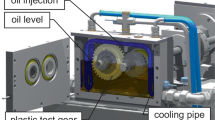Abstract
Thermoplastic materials generally show low specific weight, low coefficients of friction, noise damping behavior and demonstrate low-cost manufacturing by injection molding. This qualifies thermoplastics for the use in lightweight gear design and more generally for an increase in resource efficiency. However, moderate thermo-mechanical material properties and detrimental accumulation of contact heat limit its applications to lowly loaded machine elements. Lubrication allows pushing these boundaries. In this work, the thermo-elastohydrodynamically lubricated (TEHL) contact of steel-thermoplastic material pairings (hybrids) is analyzed by tribosimulation and at the FZG twin-disk test rig for representative thermoplastic gear operating conditions. After a comparison to plain steel TEHL contacts, the focus is on friction, film thickness and heat management. Results show that high surface conformity leads to low hydrodynamic pressures and thus very low friction. Furthermore, local contact temperatures affect tribological performance. The considered steel-thermoplastic TEHL contact operates in the transition region between hard TEHL and soft EHL.
Zusammenfassung
Im Allgemeinen weisen thermoplastische Kunststoffe eine geringe Dichte, niedrige Reibung, ein gutes Dämpfungsverhalten und kostengünstige Produktionsmöglichkeiten durch Spritzguss auf. Thermoplastische Kunststoffe eignen sich daher für leichtbauende Zahnräder und zur Steigerung der Ressourceneffizienz. Moderate mechanische Materialeigenschaften und die begrenzte Wärmeleitfähigkeit beschränken die Anwendung jedoch auf niedrig belastete Maschinenelemente. Durch eine geeignete Schmierung kann die Tragfähigkeit erhöht werden. Im vorliegenden Bericht wird daher der thermo-elastohydrodynamisch geschmierte (TEHD) Kontakt von hybriden Wälzpaarungen von Stahl und thermoplastischen Kunststoff mittels Tribosimulation und experimentellen Untersuchungen am FZG-Zweischeibenprüfstand bei für Kunststoffverzahnungen üblichen Betriebsbedingungen analysiert. Nach einem Vergleich mit TEHD Kontakten mit einer konventionellen Stahl-Wälzpaarung, werden die Reibung, die Schmierfilmdicke und der Wärmehaushalt detailliert untersucht. Die Ergebnisse zeigen eine hohe geometrische Konformität der Kontaktoberflächen, die zu niedrigen hydrodynamischen Drücken und damit zu sehr niedrigen Reibungszahlen führt. Darüber hinaus, können lokale Kontakttemperaturen das tribologische Verhalten beeinflussen. Zusammenfassend zeigt der untersuchte TEHD Kontakt einer hybriden Wälzpaarung von Stahl und thermoplastischen Kunststoff tribologische Eigenschaften, die teilweise sowohl von harten als auch von weichen TEHD Kontakten bekannt sind.








Similar content being viewed by others
References
Fürstenberger M (2013) Betriebsverhalten verlustoptimierter Kunststoffzahnräder: Verzahnungsverluste, Temperaturen, Tragfähigkeit und dynamisches Betriebsverhalten, Dissertation, TU München
Hasl C, Illenberger C, Oster P, Tobie T, Stahl K (2017) Potential of oil-lubricated plastic gears. JSME International Conference on Motion and Power Transmissions, At Kyoto, Volume: Proceedings of MPT2017-Kyoto, Vol. 2
Bartel D (2010) Simulation von Tribosystemen. Vieweg+Teubner, Wiesbaden
Marx N, Guegan J, Spikes HA (2016) Elastohydrodynamic film thickness of soft EHL contacts using optical interferometry. Tribol Int 99:267–277
Stupkiewicz S, Lengiewicz J, Sadowski P, Kucharski S (2016) Finite deformation effects in soft elastohydrodynamic lubrication problems. Tribol Int 93:511–522
de Vicente J, Stokes JR, Spikes HA (2005) The frictional properties of newtonian fluids in rolling-sliding soft-EHL contact. Tribol Lett 20(3–4):273–286
Bohan M, Fox IJ, Claypole TC, Gethin DT (2002) Numerical modelling of elastohydrodynamic lubrication in soft contacts using non–Newtonian fluids. Int J Numer Methods Heat Fluid Flow 12(4):494–511
Myant C, Spikes HA, Stokes JR (2010) Influence of load and elastic properties on the rolling and sliding friction of lubricated compliant contacts. Tribol Int 43:55–63
Johnson KL (1970) Regimes of Elastohydrodynamic lubrication. J Mech Eng Sci 12(1):9–16
Myers TG, Hall RW, Savage MD, Gaskell PH (1991) The transition region of Elastohydrodynamic lubrication. Proc R Soc Lond A Math Phys Sci 432(1886):467–479
Scarragi M, Persson B (2014) Theory of viscoelastic lubrication. Tribol Int 72:118–130
Kummer HW (1966) Unified theory of rubber and tire friction. Pa State Univ Res Bull B‑94
Hooke CJ, Huang P (1997) Elastohydrodynamic lubrication of soft viscoelastic materials in line contact. Proc Inst Mech Eng J J Eng Tribol 211(3):185–194
Pandey A, Karpitschka S, Venner CH, Snoeijer JH (2016) Lubrication of soft viscoelastic solids. J Fluid Mech 799:433–447
Simon M (1984) Messung von elasto-hydrodynamischen Parametern und ihre Auswirkung auf die Grübchentragfähigkeit vergüteter Scheiben und Zahnräder, Dissertation, TU München
Lohner T et al (2015) On the Effect of Plastic Deformation (PD) Additives in Lubricants. Tribol Schmierungstech 62:13–24
Kudish I (2016) Revision of a fundamental assumption in the Elastohydrodynamic lubrication theory and friction in heavily loaded line contacts with notable sliding. J Tribol 138:1
Poll G, Wang D (2012) Fluid rheology, traction/creep relationships and friction in machine elements with rolling contacts. J Eng Tribol 226:481–500
Lohner T, Ziegltrum A, Stemplinger J‑P, Stahl K (2016) Engineering software solution for thermal Elastohydrodynamic lubrication (TEHL) using multiphysics software. Adv Tribol 2016(2):1–13
Ziegltrum A, Lohner T, Stahl K (2017) TEHL simulation on the influence of lubricants on load-dependent gear losses. Tribol Int 113:252–261
CampusPlastics (2017) Delrin 100 NC010 (DuPont). http://www.campusplastics.com/campus/en/datasheet/Delrin%C2%AE+100+NC010/DuPont/52/6fc48544. Accessed 3 Apr 2017
Li S, Kahraman A (2010) Prediction of spur gear mechanical power losses using a transient Elastohydrodynamic lubrication model. Tribol Trans 53(4):554–563
Dowson D, Higginson GR (1961) New Roller-Bearing lubrication Formula. Engineering (Lond) 192(4972):158–159
Author information
Authors and Affiliations
Corresponding author
Rights and permissions
About this article
Cite this article
Maier, E., Ziegltrum, A., Lohner, T. et al. Characterization of TEHL contacts of thermoplastic gears. Forsch Ingenieurwes 81, 317–324 (2017). https://doi.org/10.1007/s10010-017-0230-4
Received:
Published:
Issue Date:
DOI: https://doi.org/10.1007/s10010-017-0230-4




